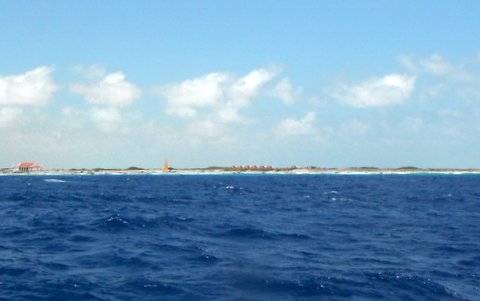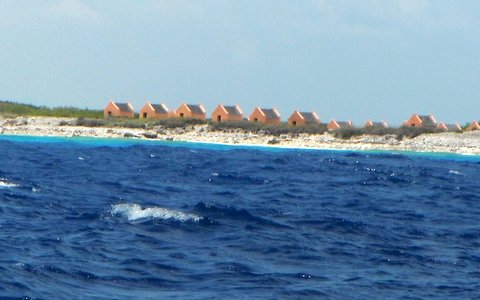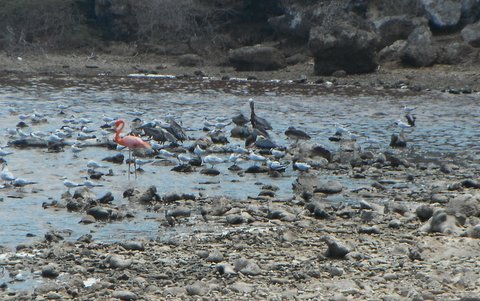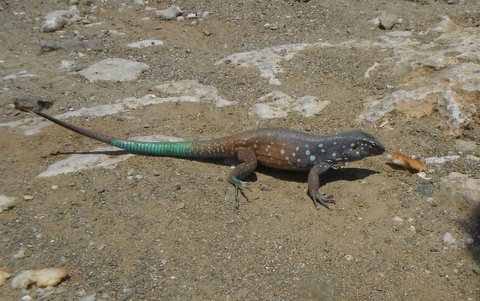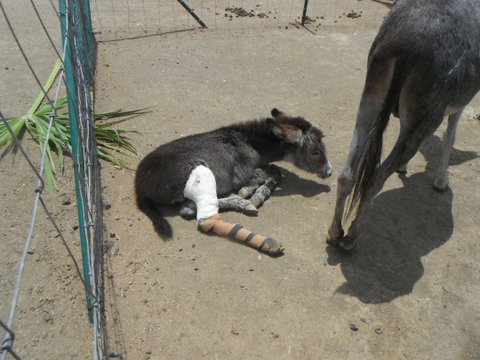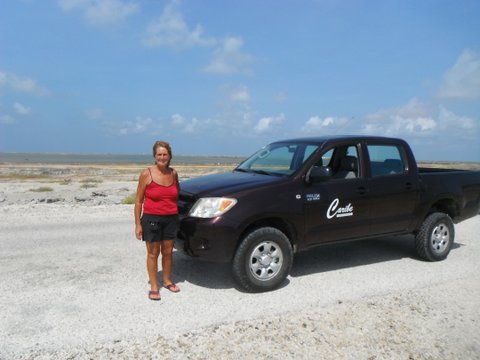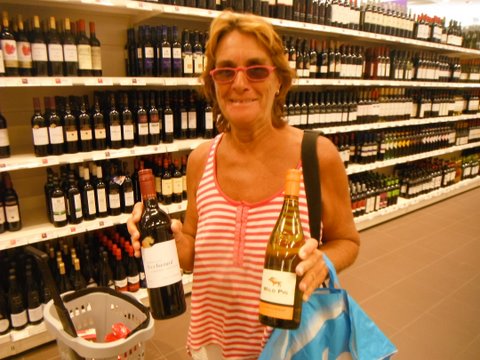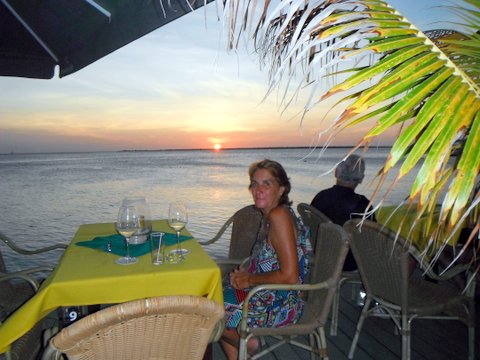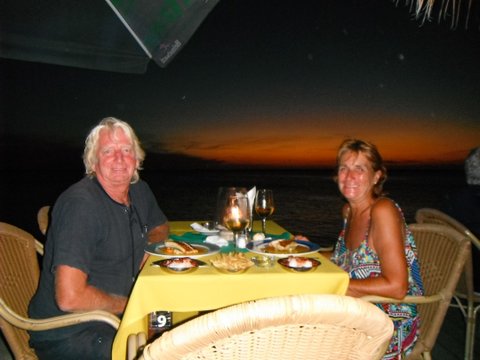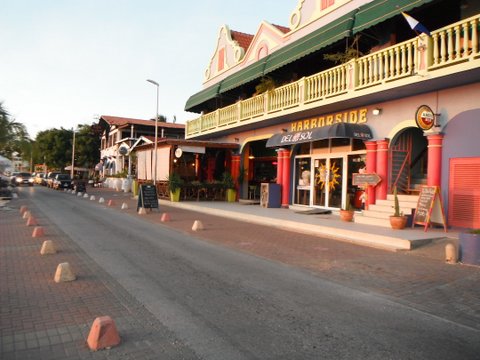Beautiful Bonaire 12.09.00N 68.16.8W

Yvonne called the coastguard at Los Aves Sotovento as we lifted anchor en route for Bonaire. It was early about 0600hrs, there was no answer. I think Yvonne must have woken them though, because half later they called us. We informed them of our departure, just politeness really, and they wished us a pleasant voyage and hope to see us again.
It is only 33 miles from here to the southern tip of Bonaire, then another 10 miles or so northwards in the lee of the island. The forecast was for 20 knots of easterly wind and 4 to 6 ft seas. Downwind no problem. We used our headsail only; Chaser is a Hunter 44FT she has a mainsail driven rig and consequently a small headsail, but that was sufficient, giving us an average speed of 7 knots.
As we neared Bonaire though the wind picked up as did the seas. We wondered if it was the shallow water picking the sea up but I don’t think so because we returned by car a few days later and the sea was calm. Still we had 30 knots of wind and maybe 10 ft seas, but behind us, so no problem, just uncomfortable. We tried to keep close to the southern tip so as to avoid having a beam sea for too long once we turned north to the anchorage.
Once we were in the lee off the island though, the wind remained but the sea was flat. They say you can have some of the best sailing here, I’m sure that is true.
From our cockpit we could see the salt mountains and the old slave huts nearby that housed the slave workers, a few years back now. The colour of the sea was amazing, Bonaire has this unique feature, its surrounded on all sides by a 10 metre deep shelf, with a sand and coral bottom. Consequently this water is pure turquoise for about 150 metres from the shore, then it drops off to 100 metres immediately and the water is a deep blue.
You are not allowed to anchor anywhere in Bonaire. However they do provide 40 mooring buoys, there is also a marina. The downside is these buoys cost 10US$ per day. We picked up a buoy; only about 10 were in use, made it fast on the bow and went back to the cockpit. It was then that you realized 10 dollars a day was a bargain. It was like anchoring in an aquarium. I have never seen water so clear, and we have been to some lovely places in our travels, even Isla Blanquilla and Isla Tortuga don’t have water like this. One could see every fish of all shapes and sizes and colours. Couldn’t wait to get in the water, which is what we did.
An hour later the customs boat came to us and asked if they could come aboard. They presented us with some papers to fill in and we gave them our passports to stamp. All done in 10 minutes, and free of charge, unlike the Venezuelan system that I’ll tell you about in the next blog.
If I remember correctly it was getting near to sundowner time, nothing better than large rum and something on arrival at your destination. We kept the dinghy on its davits until the next day, just relaxing, watching the sun go down and taking in the new environment.
Come morning we saw the sun rise, had a couple or 3 cups of tea, listened to the weather and took a stroll around the boat looking into the water. The entertainment when you through in some of the previous night’s food scraps were amazing. Sergeant major fish, parrot fish, angel fish, beautiful. What spoiled it was that everytime we went on deck the neighbours stood on their bathing platform to wash their backsides and privates, not discreetly of course. Now we can all do that when we are away from other boats, but these old men and old women were less than a 100 metres away. It was definite exhibitionism; if you did it in Hyde Park you’d be arrested. They were flying a Dutch flag, which is similar to a French flag. I said to Yvonne they must have their flag upsidedown but she thought they were Dutch, I thought that can’t be. When we launched our dinghy and motored past I was right, Belgium, a Frenchman without brains as we would jokingly say to Jean Marc at Medregal Village in Venezuela. We moved to another buoy further away.
Our first impression of Bonaire was far better than we expected and as the days went past we really liked the place. Unlike Curacao, Bonaire was village like as opposed to city like. The people of all nationalities were welcoming. There were Columbians, Argentineans, Bolivians, Europeans, many Dutch of course, though a lot of these were born and bred here.
Watersports though are the number one attraction and the Bonaire authorities really give 100% to make them attractive and available to all. There is windsurfing, Kitesurfing, Dinghy sailing of all types, kayaking, paddleboarding. One can rent a skippered sailboat, or take pleasure trips around the island. Fishing too can be arranged. Of course many of these attractions are not so attractive to us, because that is our life., but there are many European tourists here that fly in direct with KLM from Amsterdam.
Snorkeling and diving however is amazing and so well catered for. There are hundreds of dive sites; they are all given a name, and a yellow mooring buoy. Many of the sites can be enter from the shore, but they are all accessible by dinghy. You can tie up to these yellow buoys and drop into to the ocean below. Each dive site has some different inhabitants, Turtles, Rays, Sea Horses, Parrot Fish, Barracuda and large Tarpon, to mention just a few. The coral too is wonderful.
There are of course many dive centers along the shoreline where you can take a try dive as a novice, you can do a Paddy open water dive course, or more advanced courses. You can go with trained diver’s with your own gear or theirs to the most attractive sites on their specially equipped dive boats.
So if you want to learn to dive this is the place, good prices, good dive sites and good people.
Shopping ashore was a treat, remember, we are only 50 miles from the South American coast of Venezuela, but here you can get anything. One supermarket we found ‘Van Tween’ very new I think, but we could buy all our treats and cheese etc there. Wine too was good, prices were the same as Venezuela, but the selection was far better. Gato Negro sauvignon and Chardonnay was 5US$ a bottle and they had this rather civilized idea of having a screw top instead of a piece of wood they you find anywhere else!
Spirits were more expensive than we are used to in Venezuela so was Propane gas and diesel of course. We filled two Blue Camping Gaz bottles, it cost 31US$, in Venezuela it would cost us 3US$, but this includes the taxi drivers fare for doing it for us. Diesel was 1.44US$ per liter, in Venezuela we can buy 150 litres for that. The good thing in Bonaire is, ‘stuff’ is available! And there is a Budget Marine here.
There are plenty of bars and restaurants too, in the town of Kralendijk and along the shoreline. On the seafront Karols is the best in my opinion. One, because you can tie your dinghy to her dock, two, because the views at sunset looking out over the bay are beautiful, three, the bar is on the end of a jetty, so you can dine over the water. And lastly the the food is excellent, there is a long happy hour too, 5 pm till 7pm. They have an A la carte menu, which of course is the expensive way to eat. But, each day they have a 3 course special, one night we had a first course of a good mixed salad, and a bread roll, second course was a large fillet of Wahoo, this is an excellent fish anyway, but this was cooked in a Mango sauce and served with a choice of vegetables or rice and beans. The desert was chocolate brownie with a rich chocolate sauce, Yum! We were dining during happy hour, so drinks were half price, we had a good wine at 3US$ per glass and the meal totaled 18US$ each.
We also had a good Sunday BBQ lunch in town at an Argentinean restaurant, again 3 courses, lots of chicken, pork and sausage. All the water you can drink. 11US$ each, beers were 2.5US$ each
We decided to hire a car for a couple of days and tour the Island, cost was 50-60US$ per day, we had a Toyota pickup. The first day we travelled the southern half of the island. Over to the eastern side of the island, down the coast road to the southern tip. We stopped at Lac Bay a well known tourist/watersports area. Don’t know if it is was off season but the place was quite dead. There was a bar where we could get a beer, but the guy told us Sunday if we want food. We moved on south and we were interested to see the windward side of the ocean was quite calm and when we reached the shallow southern tip the sea was also calm. That gave us some confidence for our return trip. Obviously we had a bad final few hours when we arrived. We certainly didn’t want to leave in a 10ft beam sea.
We came across the salt flats as we turned northwards and stopped to visit the slave huts. These have been renovated in order to preserve the heritage of this area. These slaves worked a 5 day week, living in these huts that are 2 metres high in the centre and not much longer. Weekends the slaves were allowed to walk home to their village of Rincon, about a 7 hour walk.
As we approached the centre of the island we decided to visit the donkey sanctuary. Donkeys were used for the heavy work once slavery was abolished. Of course as machinery took over their role, the donkeys were abandoned. The donkeys then roamed and bred wild on the island. Many get run over or knocked down on the roads; some get malnourished during the dry season. So somebody has rescued these animals and it has become a tourist attraction in order to raise some money for their upkeep. There are approximately 400 donkeys in the sanctuary.
Second day of our car hire we travelled the north of the island, up the western coast road, seeing some of the magnificent dive sites and beaches, all labeled on the roadside. After passing through the town of Rincon we moved towards the state park. We entered the car park, to get our entry ticket. We had already bought our park tickets at 25 US$ each (for one year) which allows us to snorkel, Dive and visit the national park. So entry was free for us. We drove on through this very rugged and scenic route which is marked and is a one way system. There are 2 routes, one is a 90 minute drive and one is a little under 3 hours. We took the longer route, seeing some of the wild donkeys, some interesting birds and vistas.
Having the car also allowed us to stock up with some of the heavier goodies at the supermarket.
We enjoyed our two week stay on Bonaire very much but it was time to look for a weather window to leave The day was chosen, so we cleared out and left the next morning. On reaching the southern end of Bonaire we had a choice, depending on how accurate the forecast was, we could sail southwest to Bird Island, some 50 miles, then on to an anchorage call Ensa Cata, (beautiful stop over), then on to Caraballeda, (lovely restaurant in the marina), next to Carenero and anchor outside the marinas, (a beautiful anchorage) then back to Puerto La Cruz, maybe via Tortuga. We have done this route a couple of times before, sailing all the way with the contrary winds given by the mountains.
The weather though was quite calm, 10 kts of ENE wind, so we decided to cut down on the number of overnight anchorages and head midway between Tortuga and Carenero. Not a pleasant trip, we don’t like 30 hour sails. The weather was fine, but after 12 hours of sailing or motor sailing, when it’s time to put your feet up as darkness arrives, you know you have to continue another 18 hours. This is a busy shipping area, and one of the things that kept our adrenalin running during the night, were the number of ships heading for us. Having an AIS was a great advantage it tells us the ships name, their exact course and speed and position. So we can plot them and calculate any impending collision. Three times during the night we had to call a ship and ask them to change their course 10 degrees to one side or the other, and we did the same. The ships captains were all very obliging, probably thinking what the hell are these idiots doing out here this time of night. The Venezuelan Navy also called us during the night, (having heard us on channel 16), to check all was OK on board.
Morning came and as the day moved on, the wind and sea picked up a little slowing our speed towards Tortuga, so we decided to bear away and anchor in Carenero for the next night.
That was a good move; we were tired and in no rush now. We were welcomed by an enormous flock of Scarlet Ibis as we arrived, the bird life here is amazing. Next time we’ll stay longer.
The forecast was good, so the next morning we headed Northwest back out to sea to he island of Tortuga. We again spent a few nights here, resting, swimming and snorkeling before returning to PLC:
Bonaire is lovely, so we have now decided, that next year, all being well, we will return and spend longer there, a couple of months at least and maybe a month in Curacao.
Our 45 days wasn’t complete, maybe only 35 but nobody cared when we cleared back in to Venezuela.
Now back in PLC we await the arrival our daughter and 3 year old granddaughter.
These pictures were sent with Picasa, from Google.
Try it out here: http://picasa.google.com/ <<...>> <<...>> <<...>> <<...>> <<...>> <<...>> <<...>> <<...>> <<...>> <<...>> <<...>> <<...>> <<...>> <<...>> <<...>> <<...>> <<...>> <<...>>
